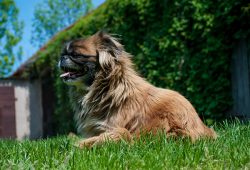The Pekingese is an ancient breed of toy dog, originating in [wiki base=”EN”]China[/wiki]. They are called Lion Dogs due to their resemblance to Chinese guardian lions (the Shih Tzu is also known as a Lion Dog in Chinese).
The breed was favored by royalty of the Chinese Imperial court as both a lap dog and companion dog, and its name refers to the city of Peking (Beijing) where the Forbidden City is located. The breed has several characteristics and health issues related to its unique appearance. Because of its desirable characteristics, the Pekingese has been part of the development of designer crossbreeds, such as the Peekapoo (crossed with a poodle) and Peke-a-tese (crossed with a Maltese).
Description
Appearance
The Pekingese breed is over 2000 years old and has hardly changed in all that time. One exception is that modern breeders and dog show judges seem to prefer the long-haired type over the more traditional spaniel-type coat.
The Pekingese’s flat face and large eyes are some of the breeds most obvious characteristics. The body is compact and low to the ground. Pekingese also have a muscular and durable body. The breed’s unusual rolling gait may have been deliberately developed by breeding to prevent the court dogs from wandering in ancient times.
Coat
All breed standards allow a wide range of color combinations. The majority of Pekingese are gold, red or sable. Cream, black, white, sables, black and tan and occasionally ‘blue’ or slate grey have appeared in the breed. The latter often has poor pigment and light eyes. Albino Pekingese (white with pink eyes) should be bred cautiously due to health problems that have been associated with albinism. The Pekingese sheds a lot.
A black mask or a self-colored face is equally acceptable in show dogs. Regardless of coat color, the exposed skin of the muzzle, nose, lips and eye rims is black.
Size
The Pekingese weigh from 7 to 14 lb (3.2 to 6.4 kg) and stand about 6–9 inches (15–23 cm) at the withers, however they can sometimes be smaller. These smaller Pekingese are commonly referred to as “Sleeve” Pekingese or just “Sleeves”. The name is taken from ancient times, when emperors would carry the smallest of the breed in their sleeves. A Pekingese over 15 pounds is disqualified in the show ring.
The Pekingese is slightly longer than tall when measured from the forechest to the buttocks. The overall outline is an approximate ratio of 3 high to 5 long.
Health
The Pekingese has a median lifespan of 11.4 years in a UK Kennel Club survey. It is normal, however for them to live anywhere between 12 and 15 years.
Care
Keeping the Pekingese coat healthy and presentable requires daily brushing, and a trip to the groomer every 8–12 weeks. One important thing for new owners to remember is that dogs intended as a house pet may be kept in a puppy cut which requires less maintenance than a show cut. It is also important to remove foreign materials from the eyes daily, and the creases on the face to prevent sores (hot spots). It is also necessary to keep and maintain the fur in the buttocks of the Pekingese clean and well groomed as the area is prone to soiling.
Due to their abundance of fur, it is important to keep the Pekingese cool. The breed is prone to have heatstroke when exposed to high temperature for a long time.
Pekingese. (2017, June 25). In Wikipedia, The Free Encyclopedia. Retrieved from https://en.wikipedia.org/w/index.php?title=Pekingese&oldid=787499751


